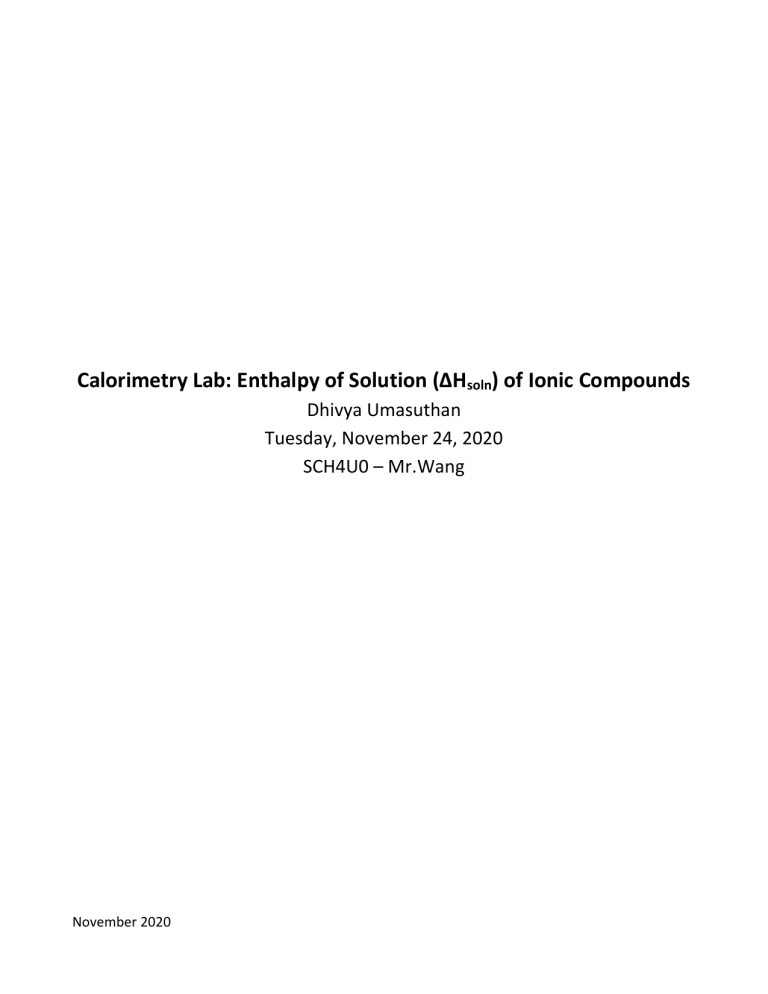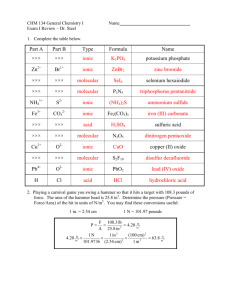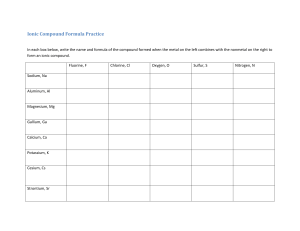
Calorimetry Lab: Enthalpy of Solution (∆Hsoln) of Ionic Compounds Dhivya Umasuthan Tuesday, November 24, 2020 SCH4U0 – Mr.Wang November 2020 SCH4U0 – Calorimetry Lab: Enthalpy of Solution (∆Hsoln) of Ionic Compounds Introduction The process of dissolving a solid in water always has an energy change associated with it. Examples of dissolving of ionic compounds exist for both endothermic and exothermic enthalpies of solution. The dissolving process itself is really a two-step process. 1) Lattice dissociation or breaking down the solid crystal. This process is endothermic. 2) Hydration or the surrounding of an ion with a layer of water molecules. This process is exothermic. For an ionic compound, ionic bonds within the crystal lattice are broken while ion-dipole forces with water are formed. Ion-dipoles are formed when the slightly positive hydrogen atoms (of the highly polar water molecules) are attracted to the negative ions. The slightly negative oxygen atoms of the polar water molecules are attracted to the positive ions. This is the hydration of the ions. The overall heat of solution depends on the relative amounts of energy involved in these two individual steps – the lattice dissociation energy and the hydration energy. In this experiment, you will determine the molar enthalpies of solution for the dissolving of some ionic compounds in water using a simple Styrofoam cup as a calorimeter. Prelab assignment 1. For each compound used in this experiment a. Calculate the number of moles present in a 1.00 g sample of each of the ionic compounds to be used in this experiment (see Reagents) b. Write the chemical equation for each compound’s dissociation in water. Calcium Chloride, CaCl2 Dissociation Equation: CaCl2 Ca2+ + Cl- M= 110.98g/mol n = m/M n = 1.00g / 110.98g/mol n = 0.009 mol Sodium Chloride, NaCl Dissociation Equation: NaCl Na+ + Cl- M= 58.44g/mol n = m/M n = 1.00g / 58.44g/mol n = 0.017 mol Ammonium chloride, NH4Cl Dissociation Equation: NH4Cl NH4+ + Cl- M= 53.491g/mol n = m/M n = 1.00g / 53.491g/mol n = 0.019 mol Sodium hydroxide, NaOH Dissociation Equation: NaOH Na+ + OH- M= 39.997g/mol n = m/M n = 1.00g / 39.997g/mol n = 0.025mol November 2020 2. What is calorimetry and draw a basic diagram of a calorimeter. Calorimetry is a process of determining the amount of heat absorbed or released during a chemical reaction. The reaction can be differentiated between exothermic (releases heat) and endothermic (absorbs heat) through measuring the change in heat. 3. Describe two factors that affect the strength of an ionic bond in a compound. The strength of an ionic bond in a compound would be directly dependant on charge and distance. The quantity of charges (electronegativity) affects the strength of an ionic bond because a cation with a charge of 2+ would create a stronger ionic bond than a cation with a 1+ charge. The strength also depends on the distance (atomic radius) between charged particles because larger ions display a farther distance between its nucleus and electrons which shows that this ionic bond weaker than smaller ions. These factors can be proven through the trends depicted on a periodic table. 4. a. Define crystal lattice energy and hydration energy Crystal lattice energy is the measure of the bond strength within an ionic compound. Hydration energy, otherwise known as hydration enthalpy is the amount of energy released when 1 mole of a gaseous ion is diluted in sufficient water. b. Which of the properties in part (a) reduces the solubility of an ionic compound? When Crystal lattice increases the solubility of an ionic compound would decrease. Crystal lattice energy represents the disassociation of ions and water molecule. Therefore, it would decrease solubility as a result. c. Which property, when increased, increases the solubility? When hydration energy increases, the solubility increases as well. The hydration energy is the association of ions and water molecules. Specifically, when the hydration energy is equal or larger than the lattice energy the substance would be soluble. November 2020 SCH4U0 – Calorimetry Lab: Enthalpy of Solution (∆Hsoln) of Ionic Compounds Objectives To find the molar enthalpy of solution for group of ionic compounds. To relate the enthalpy of solution of an ionic compound to the compound’s crystal lattice energy and hydration Apparatus Balance Styrofoam cup calorimeter Thermometer Goggles Reagents Calcium Chlorine, CaCl2 Sodium Chloride, NaCl Ammonium chloride, NH4Cl Sodium hydroxide, NaOH 50 or 100 mL graduated cylinder Safety 1. Sodium hydroxide is extremely corrosive. Eye protection must be worn at all times. 2. Ammonium chloride is a very fine powder that is potentially dangerous if it comes in contact with your eyes. Method – CREATE A LAB DOODLE (or FLOW-CHART) to summarize the procedure in your lab report 1. Add 25 mL of distilled water to a Styrofoam cup calorimeter and record the initial temperature of the water. 2. Using a balance, measure approximately 1.00 g of one of the ionic compounds and add it to the calorimeter. Record the final (maximum) temperature. 3. Rinse the calorimeter and repeat the method for a different ionic compound. 4. Record all data in a table. Include a description of the physical properties of each compound. Observations: Create an observation table (or tables) to record quantitative data you capture in this experiment. For some hints on what to include in your data table, look at analysis question 1 below: Ionic Compounds NaCl NaOH November 2020 Quantitative Properties Initial Temperature (Ti) Final Temperature (Tf) Change in Temperature (ΔT) Molar Mass (M) Mass (m) Volume (v) Initial Temperature (Ti) Final Temperature (Tf) Change in Temperature (ΔT) Molar Mass (M) Mass (m) Volume (v) = 22oC = 20oC = -2oC = 39.997 g/mol = 1.00 g = 25 mL (0.025L) = 21oC = 27oC = 6oC = 58.44 g/mol = 1.00 g = 25mL (0.025L) Analysis 1. From your data, calculate the following for each part of the experiment. (make sure it is organized) a. The temperature changes of the water NaCl NaOH Tf - Ti = ΔT Tf - Ti = ΔT 20oC - 22oC = ΔT 27oC - 21oC = ΔT -2oC = ΔT 6oC = ΔT Therefore, the temperature change of the water of the ionic compound NaCl is -2oC. Therefore, the temperature change of the water of the ionic compound NaOH, is 6oC. b. The mass of the water 25mL = 25g Therefore, the mass of the water would be 25g. c. The quantity of heat absorbed (or given off) by the water during the dissolving, given that specific heat of water is 4.184 J/g oC NaCl NaOH Given: Given: - c = 4.184 J/g oC - c = 4.184 J/g oC - m = 1.00g - m = 1.00g Q = mc ΔT Q = (25g)(4.184 J/g oC)(-2oC) Q = -209.2J Q = mc ΔT Q = (25g)( (4.184 J/g oC)( 6oC) Q = 627.6J Therefore, heat has transferred from the surroundings into the system. This is an endothermic reaction because the heat is -209.2J (negative). Therefore, heat has transferred from the system to the surroundings. This is an exothermic reaction because the heat is 627.6J (positive). d. The number of moles of solid used NaCl Given: - M = 58.44 g/mol - m = 1.00g Given: - M = 39.997 g/mol - m = 1.00g n = m/M n = 1.00g / 58.44 g/mol n = 0.017 mol n = m/M n = 1.00g / 39.997 g/mol n = 0.025 mol Therefore, the number of moles of solid used is 0.017 mol. Therefore, the number of moles of solid used is 0.025 mol. November 2020 NaOH e. The quantity of heat involved per mole of solid dissolved (value from part c divided by value from part d). This is called the molar enthalpy of solution ∆Hsoln. Assign a positive or negative sign to ∆Hsoln depending in whether you think the dissolving process was exothermic or endothermic. NaCl NaOH Qsurr = - Qrxn Qsurr = - Qrxn (-209.2J) = - Qrxn 627.6J = - Qrxn 209.2J = Qrxn - 627.6J = Qrxn ΔHrxn = Qrxn/n ΔHrxn = (209.2J) / 0.017mol ΔHrxn = 12305.88J/mol ΔHrxn = Qrxn/n ΔHrxn = (- 627.6J) / 0.025mol ΔHrxn = - 25104 J/mol 12305.88 J/mol = 12.306 kJ /mol - 25104 J/mol = - 25.104 kJ/mol Therefore, this is an endothermic reaction because there is an assigned positive sign. The amount of energy used is greater than the amount of energy released. Therefore, this is an exothermic reaction because there is an assigned negative sign. The amount of energy used is less than the amount of energy released. ΔH = Q/n ΔH = (-209.2J) / 0.017mol ΔH = - 12305.88J/mol ΔH = Q/n ΔH = (627.6J) / 0.025mol ΔH = 25104 J/mol - 12305.88 J/mol = - 12.306 kJ /mol 25104 J/mol = 25.104 kJ/mol Therefore, this is an exothermic reaction because there is an assigned negative sign. The final temperature also is less than the initial (the surrounding is absorbing heat). Therefore, this is an endothermic reaction because there is an assigned positive sign. The final temperature is also greater than the initial (the system is gaining heat). 2. Write a thermochemical equation for the dissolving process for each solid (include the heat term in each equation). NaCl NaOH NaCl(s) Na+(aq) + Cl-(aq) + (12305.88 J/mol) NaCl(s) + (12305.88 J/mol) Na+(aq) + Cl-(aq) NaOH(s) Na+(aq) + OH- (aq) + (- 25104 J/mol) NaOH(s) + (- 25104 J/mol) Na+(aq) + OH- (aq) 3. For an ionic solid to melt, external energy must be applied to overcome the attractive forces holding its ions together. For example, sodium hydroxide must be heated to temperatures exceeding 318oC for it to melt. Despite such a high melting point, sodium hydroxide readily dissolves and dissociates into its ions in water at room temperature. a. What is the source of energy required to separate the ions from the solid sodium hydroxide? The source of energy required to separate the ions from the solid sodium hydroxide is called Hydration energy, or otherwise known as Hydration Enthalpy. The association of ions and water molecules is considered November 2020 Hydration energy. The energy is the amount of heat which is discharged by the solution (sodium hydroxide), due to it becoming hydrated when the ion disassociates. b. Why does the resulting sodium hydroxide solution feel hot? The resulting sodium hydroxide solution is considered hot because the reaction is exothermic. An exothermic reaction releases energy through the forms heat and/or light. During this reaction, energy is released due to the total energy of reactants being higher than the total energy of products. Therefore, heat is continuously being emitted from the system. The reaction that occurs between the sodium ion and water molecule feels hot due to the energy release. 4. Magnesium oxide, MgO, and magnesium chloride, MgCl2, are very similar, white ionic solids with the following properties: Compound MgO MgCl2 Melting Point (oC) 2800 1412 Solubility Insoluble Very soluble a. Give the formula of the ions of each compound MgO(s) Mg2+(aq) + 02-(aq) MgCl2 Mg2+(aq) + 2Cl1- (aq) b. Account for the drastic difference in physical properties Metals and non-metals attract each other and order themselves into a lattice formation Ionic compounds are particles that form when an atom loses an electron or gains an electron (metals and nonmetals). Due to them to attracting to each other, they order themselves into a lattice formation. The high melting points are equal to the high strength of bonds. MgO has the charges of both +2 and -2 which makes their ionic bond stronger. Whereas for MgCl2 the charges are +2 and -1 for chlorine making it weaker than MgO. This meaning that MgCl2 has two separate sets of bonds to break but MgO has only one with two pairs. This indicates that MgO has a high melting point since it requires more energy to break the bond. The distance between the ions play a big role determining the compound’s bond strength. MgO has a smaller distance than MgCl2 which means it is harder to break. Due to small highly charged particles having a stronger bonding strength differentiate from large slightly charged particles which plays a role in the size effecting the melting point. The atomic radius of Chloride is bigger because of the increased number of electrons making it apparent that chlorine is a large particle. This means the bond strength of Magnesium is weak. To sum it up, since the bond between MgO is strong it takes up more energy to break making the melting point higher. MgO and MgCl 2 have a significantly different melting point. The melting point of a substance is the temperature at which it needs to be heated at to start melting. Even though these two compounds are similar, their physical properties are quite different. This all relates to the strength and bonding abilities of the compounds. The higher the strength of the bond, the higher the melting point will be. In this case, MgO is made up of two elements, which are Oxygen and Magnesium. Oxygen has a charge of -2 while Magnesium has a charge of +2. This results in their ionic bond being strong since Oxygen needs to gain 2 electrons while magnesium needs to November 2020 lose 2 electrons, making them a perfect match. However, MgCl 2 is made up of Magnesium and Chlorine. Magnesium has a charge of +2 while Chlorine has a charge of -1, making their bond weaker than MgO. Since MgO has a stronger bond, it requires more energy to break the bond, meaning it has a higher melting point. Since MgCl 2 is weaker, it requires less energy to break and has a lower melting point. In terms of solubility, when a compound is mixed in water, if they have a weak bond, the water molecules will have a greater attraction for the ions and the substance will be soluble. However, if the ions in the compound have a greater attraction with each other, the water molecules will not attract with those ions and the solution will be insoluble. Since MgO has a very strong bond, it is not soluble. However, for MgCl 2 , the water molecules have a greater attraction for the ions than the ions have for each other, therefore, it is very soluble. 5. The value of ∆Hsoln for the formation of an acetone – water solution is negative. Explain this in general terms that discuss intermolecular forces of attraction. An exothermic reaction occurred since the solution is negative. This concludes that the system lost heat and the surroundings gained heat. While this reaction is taking place, the H 2 O molecules break apart the intermolecular forces that correspond with the acetone compound. Crystal lattice dissociation is the energy required to break apart intermolecular forces. The energy which is released when a gaseous element attaches to form a bond is known as lattice energy. However, Hydration energy decides whether the reaction is exothermic or endothermic. In this case, the solute (acetone) has weaker intermolecular forces making it exothermic. If the intermolecular bonds require larger energy the reaction would be endothermic since the system would need more energy. Acetone evaporates quickly, meaning it has weak intermolecular forces. However, water evaporates slowly because its molecules are attached using hydrogen bonding, creating stronger intermolecular forces. Acetone does not have hydrogen bonding, making its intermolecular forces comparatively weaker. 1. Make a valid conclusion, based on the correct interpretation of the results, with an explanation to the process that will determine whether a reaction will be endothermic or exothermic. 2. Write a mathematical equation that shows the relationship between ∆Hsoln, Q (heat) and n (moles). Lab Report Submission Details: o Pre-Lab o Lab Report –Doodle or flow-chart of the Procedure, Observations Table(s), Analysis Questions, and Conclusion o Lab report is due on: __Sunday November 29th @ 11:50pm (dropbox)____________. RUBRIC WILL BE POSTED LATER November 2020






